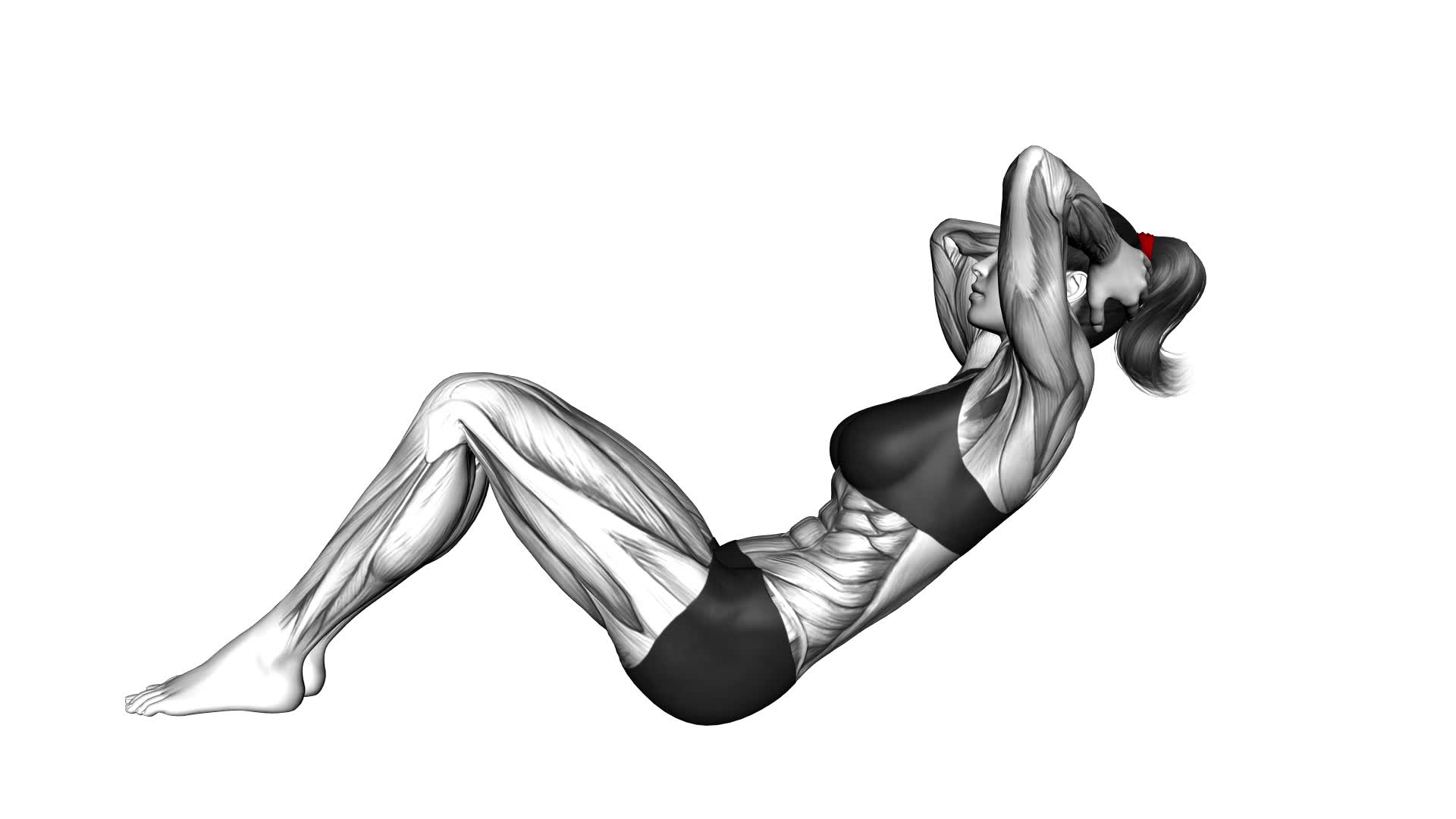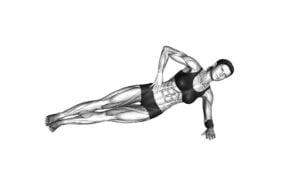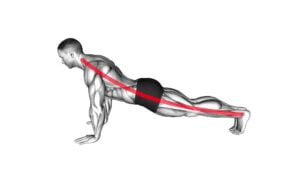Crunch – Back (WRONG RIGHT) (female) – Video Exercise Guide & Tips

Are you looking to perfect your crunch-back exercise?
Watch This Exercise Video
In this video exercise guide, we'll help you avoid common mistakes and show you the correct form and technique.
Whether you're a fitness enthusiast or just starting out, we've got tips and modifications specifically for females.
Get ready to maximize your results and strengthen your back with this informative and concise workout guide.
Let's get crunching!
Key Takeaways
- Common mistakes and modifications include relying solely on the neck and shoulders to lift the upper body and using momentum instead of core strength.
- Correct form and technique involve keeping the feet flat on the floor with knees bent at a 90-degree angle and exhaling as the upper body is lifted off the floor using abdominal muscles.
- The benefits of the crunch-back exercise include targeting and strengthening abdominal muscles, as well as engaging lower back muscles for improved core stability and posture.
- Maximizing intensity and results can be achieved by increasing resistance with weights or resistance bands, paying attention to form and technique, and incorporating intervals of high-intensity exercises to boost calorie burn.
Common Mistakes to Avoid
To avoid common mistakes when performing the Crunch – Back exercise, always remember to consistently engage your core muscles. One common mistake to avoid is relying solely on your neck and shoulders to lift your upper body off the ground. Instead, focus on using your abdominal muscles to initiate the movement. Another mistake is using momentum to swing your body up, rather than relying on your core strength. This not only reduces the effectiveness of the exercise but also increases the risk of injury. To avoid this, maintain a slow and controlled movement throughout the entire exercise. Additionally, make sure to keep your lower back pressed firmly against the floor to prevent excessive strain on the spine.
For female fitness enthusiasts, there are a few modifications that can be made to the Crunch – Back exercise. If you're pregnant or have recently given birth, it's important to consult with your healthcare provider before attempting this exercise. They may recommend alternative exercises that are more suitable for your current condition. Additionally, if you have diastasis recti, a condition characterized by a separation of the abdominal muscles, it's important to avoid exercises that can worsen the condition. In this case, it may be beneficial to work with a certified fitness professional who can provide modifications and guidance specific to your needs.
Always listen to your body and make any necessary adjustments to ensure a safe and effective workout.
Correct Form and Technique
Engage your core muscles and focus on using your abdominal muscles to initiate the Crunch – Back exercise, ensuring proper form and technique. To perform this exercise correctly, follow these tips:
- Keep your feet flat on the floor and your knees bent at a 90-degree angle.
- Place your hands lightly behind your head, avoiding any pulling or tugging on your neck.
- Exhale as you lift your upper body off the floor, using your abdominal muscles to curl your shoulders towards your hips.
- Avoid yanking on your head or neck with your hands, as it can strain your neck and reduce the effectiveness of the exercise.
- Maintain a smooth and controlled movement, avoiding any jerking or momentum.
- Keep your lower back pressed into the floor to engage your core muscles properly.
Correct form and technique are crucial for maximizing the benefits of the Crunch – Back exercise. By focusing on utilizing your abdominal muscles and avoiding common misconceptions, you can effectively strengthen your core.
However, if you find this exercise challenging or uncomfortable, there are alternative exercises you can try. Plank variations, such as the forearm plank or side plank, engage your core while also targeting other muscle groups. Additionally, exercises like the bicycle crunch or Russian twist provide a dynamic and engaging workout for your abs.
Remember to consult with a fitness professional to ensure proper form and technique for any exercise you choose.
Benefits of Crunch – Back Exercise
Now let's talk about the benefits of the crunch – back exercise. By maintaining proper form and technique, you can effectively target and strengthen your abdominal muscles, including the rectus abdominis and obliques.
This exercise also engages your lower back muscles, helping to improve core stability and posture.
Proper Form for Crunches
Maintain proper form during crunches to maximize the benefits of the crunch-back exercise. To ensure that you're performing crunches correctly, keep the following points in mind:
- Common Misconceptions:
- Avoid pulling on your neck or using your hands to lift your upper body. This can strain your neck and reduce the effectiveness of the exercise.
- Don't arch your back excessively or lift your lower back off the ground. This can lead to lower back pain and diminish the engagement of your abdominal muscles.
- Variations:
- Try incorporating different variations of crunches, such as bicycle crunches or reverse crunches, to target different areas of your core and enhance overall strength and stability.
- Progressions:
- Gradually increase the difficulty of your crunches by adding weights, using an exercise ball, or performing advanced variations like the Russian twist. This will challenge your core muscles and promote continual progress.
Muscles Targeted During Crunches
To maximize the benefits of the crunch-back exercise, it's important to target specific muscles and understand the advantages it offers.
Crunches primarily target the abdominal muscles, specifically the rectus abdominis, which is responsible for flexing the spine. This exercise also engages the obliques, which are located on the sides of the waist and aid in rotational movements. In addition, crunches activate the transverse abdominis, a deep muscle that helps stabilize the core.
By strengthening these muscles, crunches can improve core stability, enhance posture, and contribute to a stronger, more defined midsection.
To add variety to your workout routine, you can try different variations of crunches, such as bicycle crunches, reverse crunches, or weighted crunches.
Remember to maintain proper form and gradually increase the intensity to avoid injury and maximize the benefits of this exercise.
Equipment Needed for Crunch – Back Exercise
You'll need a mat and a stability ball to perform the Crunch – Back exercise correctly. Here are some key points about the equipment needed for this exercise:
- Mat: A mat provides cushioning and support for your back during the exercise. It helps to protect your spine and prevent discomfort or injury.
- Stability Ball: The stability ball, also known as an exercise ball or Swiss ball, is a versatile piece of equipment that adds an extra challenge to the Crunch – Back exercise. It engages more muscles, including your core, as you balance on the ball.
- Exercise Variations: Once you have mastered the basic Crunch – Back exercise, you can try different variations to target your back muscles from different angles. Some variations include performing the exercise with your feet elevated, using a resistance band, or adding a twist at the top of the movement.
- Alternative Workouts: If you don't have access to a stability ball, you can still work your back muscles effectively with alternative exercises. Some alternatives include the Superman exercise, reverse crunches, or seated cable rows.
Remember to consult with a fitness professional or trainer to ensure you're using the equipment correctly and performing the exercises safely and effectively.
Modifications for Female Fitness Enthusiasts
To modify the Crunch – Back exercise for female fitness enthusiasts, consider using lighter weights to target specific back muscles. This modification can help prevent strain or injury, especially for pregnant women or those recovering from childbirth. It's important to consult with a healthcare professional before starting or modifying any exercise routine during pregnancy. For pregnant women, modifications may include using lighter weights or even opting for bodyweight exercises to reduce the risk of abdominal separation or diastasis recti.
Crunches can be beneficial for postpartum recovery as they help strengthen the core muscles. This can be particularly important for restoring abdominal strength and stability after childbirth. However, it's crucial to listen to your body and avoid any exercises that cause pain or discomfort. If you experience any pelvic or back pain, it's advisable to modify or avoid crunches altogether and focus on exercises that are safe and appropriate for your postpartum body.
Transition: Now that you understand how to modify the Crunch – Back exercise for female fitness enthusiasts, let's move on to some tips for maximizing your results.
Tips for Maximizing Results
For optimal results, incorporate these tips into your Crunch – Back exercise routine.
- Maximizing Intensity
- Increase the resistance: By using weights or resistance bands during your crunch-back exercises, you can challenge your muscles and increase the intensity of your workout. This will help you build strength and tone your back more effectively.
- Focus on form: Pay close attention to your form and technique during each repetition. By maintaining proper alignment and engaging the correct muscles, you can maximize the effectiveness of each crunch-back movement.
- Incorporate intervals: Intervals of high-intensity exercises can help boost calorie burn and maximize your workout results. Consider adding short bursts of high-intensity crunch-back exercises between sets to increase the overall intensity of your routine.
- Effective Variations
- Bicycle crunches: This variation targets not only your back but also your abs and obliques. By alternating your knees and elbows in a bicycling motion, you engage multiple muscle groups simultaneously for a more effective workout.
- Stability ball crunches: Using a stability ball adds an element of instability, forcing your back muscles to work harder to maintain balance. This variation can help increase core strength and improve overall stability.
- Reverse crunches: Instead of lifting your upper body, reverse crunches involve lifting your hips off the ground, targeting your lower back and lower abs. This variation can be a great addition to your crunch-back routine for a more well-rounded workout.
Incorporating these tips into your crunch-back routine will help you maximize the intensity of your workouts and increase the effectiveness of each exercise variation.
Remember to listen to your body, adjust the intensity as needed, and stay consistent with your routine to achieve the best results.
Frequently Asked Questions
How Many Calories Can You Burn Doing Crunch – Back Exercise?
Incorporating crunch-back exercises into your daily routine offers numerous benefits.
Not only does it target and strengthen your back muscles, but it also helps improve posture and stability.
To maximize calorie burn during this exercise, focus on maintaining proper form and engaging your core throughout each repetition.
Additionally, increasing the intensity by adding weights or performing variations like bicycle crunches can further enhance the calorie-burning effect.
Make sure to consult a fitness professional for personalized guidance and to avoid any potential injury.
Can Crunch – Back Exercise Help Reduce Back Pain?
Yes, the crunch – back exercise can help reduce back pain. By strengthening the muscles in your back, you can improve your posture and alleviate strain on your spine.
Additionally, incorporating stretching into your routine can further relieve back pain. Stretching helps to increase flexibility, promote blood flow, and release tension in the muscles.
Is It Necessary to Use a Mat While Performing Crunch – Back Exercise?
Yes, it's necessary to use a mat while performing the crunch – back exercise.
Using a mat provides cushioning and support for your back, ensuring proper form and technique.
Performing the exercise without a mat can put unnecessary strain on your spine and may lead to discomfort or injury.
Incorporating the crunch – back exercise into your full body workout routine has numerous benefits, including strengthening your core, improving posture, and reducing lower back pain.
Are There Any Alternative Exercises That Can Target the Same Muscle Groups as Crunch – Back Exercise?
If you're looking for alternative exercises that target the same muscle groups as the crunch-back exercise, there are a few options you can try.
Plank variations, such as the side plank or mountain climbers, engage your core and back muscles.
Supermans and bird dogs are also effective in strengthening your back.
These exercises provide similar benefits to the crunch-back exercise by improving core stability and promoting a strong and healthy back.
How Many Repetitions and Sets Should Be Done for Crunch – Back Exercise to See Results?
To see results from the crunch-back exercise, it's important to perform the proper form and technique.
Start by lying on your back with your knees bent and feet flat on the floor.
Place your hands behind your head, but avoid pulling on your neck.
Engage your core and lift your shoulders off the ground while exhaling.
Lower back down with control and repeat for the desired number of repetitions and sets.
Avoid common mistakes like using momentum or straining your neck.
Conclusion
In conclusion, the crunch-back exercise is a beneficial workout for female fitness enthusiasts.
By avoiding common mistakes and maintaining correct form and technique, this exercise can help strengthen and tone the back muscles.
With the right equipment and modifications, women can customize this exercise to suit their fitness level and goals.
By following these tips and maximizing their efforts, women can achieve optimal results from the crunch-back exercise.

Author
Years ago, the spark of my life’s passion ignited in my mind the moment I stepped into the local gym for the first time. The inaugural bead of perspiration, the initial endeavor, the very first surge of endorphins, and a sense of pride that washed over me post-workout marked the beginning of my deep-seated interest in strength sports, fitness, and sports nutrition. This very curiosity blossomed rapidly into a profound fascination, propelling me to earn a Master’s degree in Physical Education from the Academy of Physical Education in Krakow, followed by a Sports Manager diploma from the Jagiellonian University. My journey of growth led me to gain more specialized qualifications, such as being a certified personal trainer with a focus on sports dietetics, a lifeguard, and an instructor for wellness and corrective gymnastics. Theoretical knowledge paired seamlessly with practical experience, reinforcing my belief that the transformation of individuals under my guidance was also a reflection of my personal growth. This belief holds true even today. Each day, I strive to push the boundaries and explore new realms. These realms gently elevate me to greater heights. The unique combination of passion for my field and the continuous quest for growth fuels my drive to break new ground.



